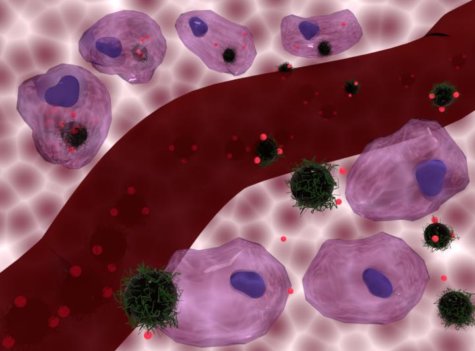LONDON — Chemotherapy has been a major tool in cancer treatment for the better part of a century. Unfortunately, it’s a treatment that often constitutes a “roll of the dice” for patients. There’s no guarantee in most cases that chemotherapy will successfully kill all cancer cells. Now, researchers from University College London may have uncovered a way to increase the effectiveness of chemotherapy. Their study finds that heating up cancer cells while they’re being targeted with chemotherapy is a “highly effective” avenue for eliminating them.
More specifically, researchers find “loading” a chemotherapy drug on to tiny magnetic particles capable of heating up cancer cells while simultaneously delivering the chemotherapy to them is over 34 percent more effective than just chemotherapy with no heat.

Journal of Materials Chemistry B / Nguyen T. K. Thanh / Florian Aubrit / Olivier Sandre / Lilin Wang)
Study authors say chemotherapy and heat appear to have a synergistic effect on one another. This means both methods are more effective when doctors use them in combination instead of separately. While very promising, the team cautions that these experiments took place on cells in a lab setting. More research on human subjects is needed before moving on to any clinical trials.
Nanoparticles heat the way
The chemotherapy drug is transported through patients’ bodies via magnetic iron oxide nanoparticles. Those nanoparticles actively shed heat when exposed to an alternating magnetic field. Once enough nanoparticles gather together inside the tumor, doctors apply the alternating magnetic field from outside the body. The end result of all this being a simultaneous delivery of both heat and chemotherapy.
“Our study shows the enormous potential of combining chemotherapy with heat treatment delivered via magnetic nanoparticles,” says senior author Professor Nguyen T. K. Thanh in a university release. “While this combination of therapy is already approved for the treatment of fast-growing glioblastomas, our results suggest it has potential to be used more widely as a broad anti-cancer therapy.”
“This therapy also has potential to reduce the side effects of chemotherapy, by ensuring it is more highly targeted on cancer cells rather than healthy tissue. This needs to be explored in further pre-clinical tests,” the researcher in the Department of Physics & Astronomy adds.
The study makes use of the chemotherapy drug doxorubicin for their experiments. The team tested the new treatment on human breast and brain cancer cells as well as mouse prostate cancer cells.
A rapid treatment for brain cancer?
The study’s most successful test, which included a combination of both heat and doxorubicin, resulted in the death of 98 percent of brain cancer cells after just 48 hours. Meanwhile, doxorubicin alone only killed 73 percent of brain cancer cells. For breast cancer cells, the combined treatment killed 89 percent within two days. Doxorubicin alone killed only 77 percent.
Cancer cells are quite vulnerable to heat in comparison to normal, healthy cells. A cancer cell starts undergoing a slow death at around 107 degrees Fahrenheit. Healthy cells on the other hand can withstand temperatures up to 113 degrees.
Even when cancer cells were heated up by just a few degrees, the chemotherapy became more effective. This suggests that high doses of nanoparticles may not be necessary to successfully help certain cancer patients.
“Since heat can be generated through the alternating magnetic field, the release of the drug can be highly localized to cancer cells, potentially reducing side effects,” concludes co-author Dr. Olivier Sandre from the University of Bordeaux.
The study is published in Journal of Materials Chemistry B.
